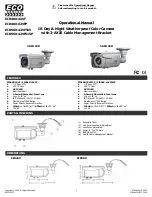
V1.02
Thom Hogan’s Complete Guide to the Nikon D300
Page 31
• The color LCD on the back of the D300 has expanded to
3” from the 2.5” one used on the D200. More
importantly, the D300 color LCD now uses 922,000
individual dots to display pictures and menus compared
to the 230,000 dots used on the D200. The color LCD
now supports an optional D40-like Control Panel view
during shooting. Video output has changed, too: the D300
now supports HDMI output in addition to composite
video.
• The D300 has two “live view” modes where you can
preview images from the sensor on the color LCD
prior
to
shooting. Autofocus and metering are still active in this
shooting mode.
• The CompactFlash card slot now supports UDMA (Ultra
Direct Memory Access), a very fast writing technique
available on state-of-the-art cards. The difference is not
subtle: a UDMA card can write faster than 35MB/sec
versus the D200’s 9MB/sec maximum.
• Finally, the vertical grip attachment has changed. Where
the D200’s MB-D200 used a connection that required the
battery door to be removed and the MB-D200 inserted
into the camera’s battery chamber, the new MB-D10
mounts to contacts on the bottom of the D300 (under a
rubber door).
Yes, that’s a lot of changes (and there are some more minor
ones that I haven’t mentioned), especially considering the
two-year period between the two camera introductions.
Nikon’s engineers have been busy. It’s quite impressive just
how much better the D300 is than the D200 in so many
areas.
Curiously, the differences between the D300 and the D3 are
less remarkable:
• The big difference is the sensor. The D3 uses a larger FX
sensor, and that sensor has a number of aspects that give it
improved image quality over the D300, mostly at higher
















































